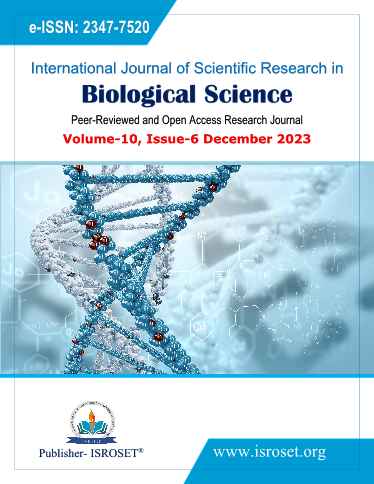Computational study on Polydatin with the Human Alpha-Defensins and the Human Beta Defensins evaluated by Blind Molecular Docking method
Keywords:
Polydatin, Autodock Vina, Pyrx, Human Defensins,, Piceid, Human Beta-Defesin-2Abstract
In a comprehensive Molecular Docking investigation using Autodock Vina with the Pyrx program, six Human Defensins (Alpha Defensin-1, Alpha Defensin-3, Alpha Defensin-4, Beta-Defensin-1, Beta-Defensin-2, Beta Defensin-3) were studied alongside various natural compounds. Notably, all investigated compounds exhibited similar binding energy scores with Human Alpha Defensin-1 and Alpha Defensin-3, around -6.0 kcal/mol. However, with Human Defensin-4, Astringin, and Rhapontin, greater energetic affinities were observed, approximately -7.5 kcal/mol, compared to Polydatin and Eleutheroside-B. In the case of Beta-defensins, the natural compounds demonstrated higher binding capacities compared to Alpha defensins. Specifically, Polydatin exhibited a noteworthy binding affinity with Human Beta-Defensin-2, with a Vina Score of approximately -9.2 kcal/mol. Astringins and Rhapontis also showed significant binding energies with Human Beta-Defensin-2, with Vina scores of -8.8 kcal/mol and -8.6 kcal/mol, respectively. While these computational findings are preliminary and rely on a Blind Docking approach, they suggest that Polydatin and its derivatives may have a higher binding affinity for Beta-Defensins, particularly Beta-Defensin-2, providing a theoretical basis for further biological and molecular studies.
References
Bun Ng, T., Chi Fai Cheung, R., Ho Wong, J., & Juan Ye, X. Antimicrobial activity of defensins and defensin-like peptides, 2013.
Antcheva, N., Zelezetsky, I., & Tossi, A. Cationic antimicrobial peptides—the defensins. In Handbook of biologically active peptides Academic Press, pp.55-66, 2006.
Lehrer, R. I. Evolution of antimicrobial peptides: a view from the cystine chapel. In Antimicrobial Peptides and Innate Immunity , Basel: Springer Basel, pp.1-27, 2012.
Shafee, T. M., Lay, F. T., Hulett, M. D., & Anderson, M. A. The defensins consist of two independent, convergent protein superfamilies. Molecular biology and evolution, Vol.33, Issue.9, pp.2345-2356, 2016.
Parisi, K., Shafee, T. M., Quimbar, P., van der Weerden, N. L., Bleackley, M. R., & Anderson, M. A. The evolution, function and mechanisms of action for plant defensins. In Seminars in cell & developmental biology, Academic Press, Vol.88, pp.107-118, 2019.
Silva, P. M., Gonçalves, S., & Santos, N. C. Defensins: antifungal lessons from eukaryotes. Frontiers in microbiology, Vol.5, Issue. 97, 2014.
Mattar, E. H., Almehdar, H. A., Yacoub, H. A., Uversky, V. N., & Redwan, E. M. Antimicrobial potentials and structural disorder of human and animal defensins. Cytokine & Growth Factor Reviews, Vol.28, pp.95-111, 2016.
Schröder, J. M. Epithelial antimicrobial peptides: innate local host response elements. Cellular and Molecular Life Sciences CMLS, Vol.56, pp.32-46,1999.
Ravagnan, G., De Filippis, A., Cartenì, M., De Maria, S., Cozza, V., Petrazzuolo, M., & Donnarumma, G. Polydatin, a natural precursor of resveratrol, induces ?-defensin production and reduces inflammatory response. Inflammation, Vol.36, pp.26-34, 2013.
Liu, H. B., Meng, Q. H., Huang, C., Wang, J. B., & Liu, X. W. Nephroprotective effects of polydatin against ischemia/reperfusion injury: a role for the PI3K/Akt signal pathway. Oxidative medicine and cellular longevity, 2015.
Ma, Y., Gong, X., Mo, Y., & Wu, S. Polydatin inhibits the oxidative stress-induced proliferation of vascular smooth muscle cells by activating the eNOS/SIRT1 pathway. International journal of molecular medicine, Vol.37, Issue.6, pp.1652-1660, 2016.
Hao, J., Chen, C., Huang, K., Huang, J., Li, J., Liu, P., & Huang, H. Polydatin improves glucose and lipid metabolism in experimental diabetes through activating the Akt signaling pathway. European journal of pharmacology, Vol.745, pp.152-165, 2014.
Fan, J., Fu, A., & Zhang, L. Progress in molecular docking. Quantitative Biology, Vol.7, pp.83-89, 2019.
Morris, G. M., & Lim-Wilby, M.Molecular docking. Molecular modeling of proteins, pp.365-382, 2008.
Huey, R., Morris, G. M., & Forli, S. Using AutoDock 4 and AutoDock vina with AutoDockTools: a tutorial. The Scripps Research Institute Molecular Graphics Laboratory, Vol.10550, Issue.92037,pp.1000,2012.
Ferrari, I. V., De Gregorio, A., Fuggetta, M. P., Ravagnan, G., Ali, W., Perrella, F., & Abdalla, M. Focus on Polydatin Interaction with Sirtuins Family: a Comparative Computational Analysis. Int. J. Sci. Res. in Biological Sciences Vol.10, Issue.3, 2023.
Ferrari, I. V. Computational Studies of Human Sodium/glucose cotransporters:(SGLT1),(SGLT2) and investigation of Human Sirtuins together with Polydatin. bioRxiv, 2023.
Ferrari, I. V., De Gregorio, A., Fuggetta, M. P., & Ravagnan, G. PharmMapper Server and Molecular Docking Study Focusing on Polydatin to Identify Potential Targets. European Journal of Applied Sciences, Vol.11, Issue.52023.
Houtkooper, R. H., Pirinen, E., & Auwerx, J. Sirtuins as regulators of metabolism and healthspan. Nature reviews Molecular cell biology, Vol.13, Issue.4, pp.225-238, 2012.
Pawar, Rutuja P., and Sachin H. Rohane. "Role of autodock vina in PyRx molecular docking, pp.132-134,2021.
Pettersen, E. F., Goddard, T. D., Huang, C. C., Couch, G. S., Greenblatt, D. M., Meng, E. C., & Ferrin, T. E. UCSF Chimera—a visualization system for exploratory research and analysis. Journal of computational chemistry, Vol.25, Issue.13, pp.1605-1612, 2004.
Johansson, M. U., Zoete, V., Michielin, O., & Guex, N. Defining and searching for structural motifs using DeepView/Swiss-PdbViewer. BMC bioinformatics, Vol.13, pp.1-11, pp.2012.
Downloads
Published
How to Cite
Issue
Section
License

This work is licensed under a Creative Commons Attribution 4.0 International License.
Authors contributing to this journal agree to publish their articles under the Creative Commons Attribution 4.0 International License, allowing third parties to share their work (copy, distribute, transmit) and to adapt it, under the condition that the authors are given credit and that in the event of reuse or distribution, the terms of this license are made clear.







